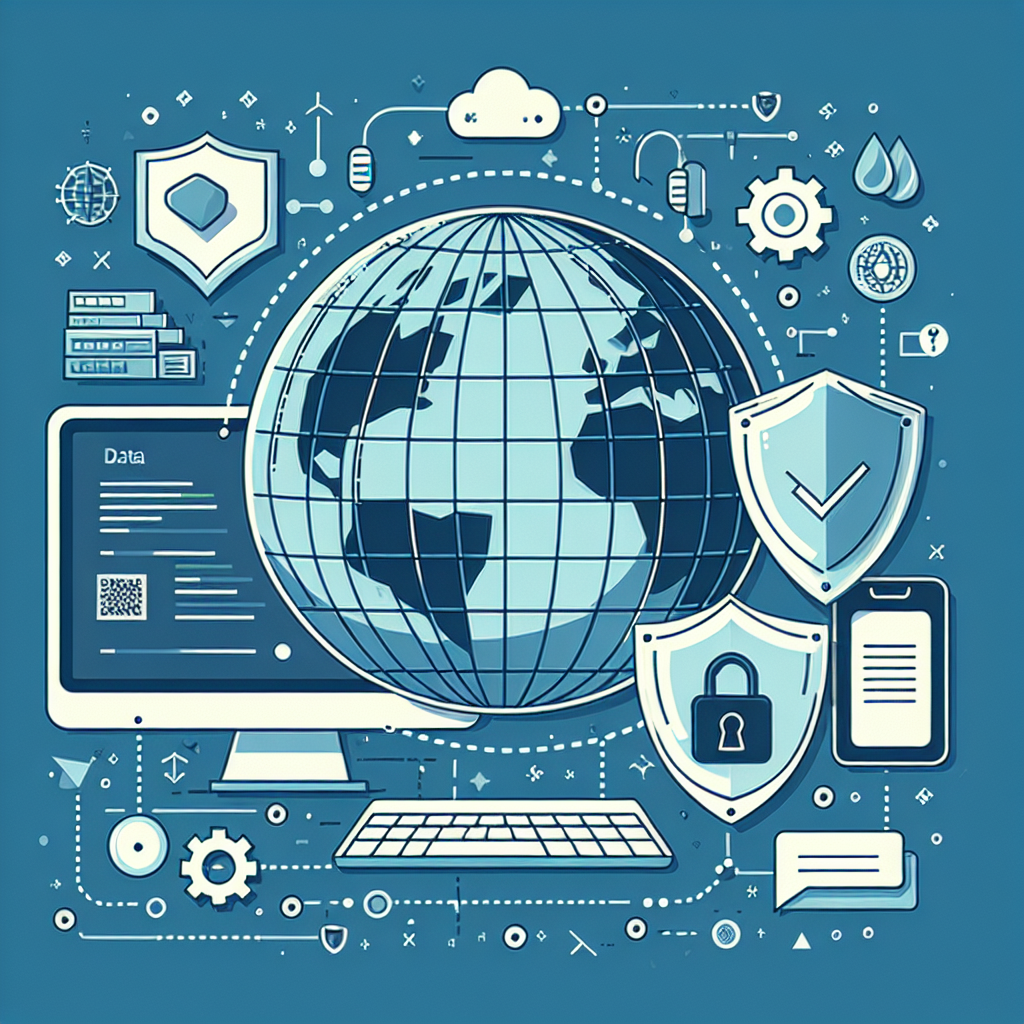Your cart is currently empty!
Tag: Ensuring

Data Backup and Recovery: Ensuring Business Continuity in a Digital Age
In today’s digital age, data is one of the most valuable assets for businesses. From customer information to financial records, companies rely on data to operate effectively and efficiently. However, with the increasing amount of data being generated and stored, the risk of data loss is also on the rise. This is why having a robust data backup and recovery plan is crucial for ensuring business continuity.Data backup is the process of making copies of data in case the original data is lost or damaged. It involves creating duplicate copies of important files and storing them in a secure location. This ensures that in the event of a hardware failure, cyber-attack, or natural disaster, businesses can quickly recover their data and resume operations without experiencing significant downtime.
There are several methods of data backup, including onsite backups, offsite backups, and cloud backups. Onsite backups involve storing data on physical devices such as external hard drives or tape drives located within the premises of the business. Offsite backups, on the other hand, involve storing data at a remote location, such as a data center or colocation facility. Cloud backups, which have become increasingly popular in recent years, involve storing data on remote servers accessed via the internet.
In addition to regular data backups, businesses also need to have a solid data recovery plan in place. Data recovery is the process of restoring data from backups in the event of data loss. This involves identifying the cause of the data loss, retrieving the backup data, and restoring it to the original location. Having a well-defined data recovery plan can help businesses minimize the impact of data loss and quickly get back up and running.
When developing a data backup and recovery plan, businesses need to consider several factors, including the type and amount of data being stored, the frequency of backups, and the retention period for backup data. They also need to ensure that backups are encrypted and stored securely to protect against unauthorized access and data breaches.
Overall, data backup and recovery are essential components of a business’s IT infrastructure. By implementing a comprehensive backup and recovery plan, businesses can safeguard their data and ensure business continuity in the face of unforeseen events. In today’s digital age, where data is king, investing in a robust data backup and recovery solution is not just a best practice – it’s a business imperative.

Ensuring Business Resilience: The Role of Business Continuity in Risk Management
In today’s fast-paced and unpredictable business environment, ensuring business resilience is more important than ever. With the increasing frequency of natural disasters, cyber attacks, and economic downturns, organizations must be prepared to handle any unexpected disruptions that may come their way. One crucial element of this preparedness is having a strong business continuity plan in place.Business continuity is the process of developing strategies and plans to ensure that a company can continue operating in the face of unexpected events. This includes identifying potential risks, assessing their potential impact on the business, and implementing measures to mitigate those risks. By having a solid business continuity plan in place, organizations can minimize downtime, reduce financial losses, and maintain the trust of their customers and stakeholders.
The role of business continuity in risk management cannot be overstated. By identifying potential risks and developing strategies to address them, organizations can better protect their assets, employees, and reputation. This proactive approach can also help businesses comply with regulatory requirements and industry standards, ultimately improving their overall resilience and sustainability.
One key aspect of business continuity planning is conducting a thorough risk assessment. This involves identifying and analyzing potential risks that could disrupt business operations, such as natural disasters, cyber attacks, supply chain disruptions, and human error. By understanding these risks, organizations can develop strategies to mitigate their impact and ensure the continuity of their operations.
Another important component of business continuity planning is developing a comprehensive response and recovery plan. This includes establishing clear roles and responsibilities, communication protocols, and backup systems to ensure that critical functions can continue in the event of a disruption. By having a well-defined plan in place, organizations can quickly respond to emergencies and minimize the impact on their business.
In addition to developing a strong business continuity plan, organizations must also regularly test and update their strategies to ensure their effectiveness. This may involve conducting tabletop exercises, simulations, and drills to identify weaknesses and areas for improvement. By continuously evaluating and refining their business continuity plans, organizations can better prepare for potential disruptions and enhance their overall resilience.
In conclusion, ensuring business resilience requires a proactive approach to risk management, with business continuity playing a crucial role in this process. By identifying potential risks, developing comprehensive response and recovery plans, and regularly testing and updating their strategies, organizations can better protect their operations and maintain business continuity in the face of unexpected events. Ultimately, investing in business continuity is an essential step towards building a resilient and sustainable business for the future.

The Role of Service Level Agreements (SLAs) in Ensuring Customer Satisfaction
Service Level Agreements (SLAs) play a crucial role in ensuring customer satisfaction in today’s competitive business environment. An SLA is a contractual agreement between a service provider and a customer that outlines the level of service that the provider will deliver. These agreements are essential in establishing clear expectations and performance metrics for both parties, ultimately leading to improved customer satisfaction.One of the key benefits of SLAs is that they provide a clear understanding of the services that will be provided and the responsibilities of both the service provider and the customer. By clearly defining the scope of services, response times, and performance metrics, SLAs help to eliminate misunderstandings and ensure that both parties are on the same page. This transparency fosters trust and accountability, which are essential for building strong, long-lasting relationships with customers.
SLAs also help to set performance standards and hold service providers accountable for meeting those standards. By specifying key performance indicators (KPIs) such as response times, uptime, and resolution times, SLAs provide a benchmark for measuring the quality of service. This not only helps to identify areas for improvement but also ensures that customers receive the level of service they expect and deserve.
In addition, SLAs help to prioritize service delivery based on the needs and preferences of the customer. By outlining service levels for different types of issues or requests, SLAs ensure that critical issues are addressed promptly and efficiently, while less urgent issues are handled in a timely manner. This helps to streamline the service delivery process and ensure that customers receive the level of service that they require.
Furthermore, SLAs can also help to improve communication between service providers and customers. By establishing clear channels of communication and escalation procedures, SLAs ensure that issues are addressed promptly and effectively. This not only helps to resolve problems quickly but also demonstrates to customers that their concerns are being taken seriously.
Overall, the role of SLAs in ensuring customer satisfaction cannot be overstated. By establishing clear expectations, setting performance standards, prioritizing service delivery, and improving communication, SLAs help to build trust, accountability, and strong relationships with customers. In today’s competitive business environment, having strong SLAs in place is essential for delivering high-quality service and ultimately driving customer satisfaction.

The Role of Managed Services in Ensuring Business Continuity and Disaster Recovery
In today’s fast-paced business environment, ensuring business continuity and disaster recovery is crucial for the survival and success of any organization. Unexpected events such as natural disasters, cyber attacks, or hardware failures can disrupt operations and lead to significant financial losses. This is where managed services play a crucial role in helping businesses mitigate risks and ensure uninterrupted operations.Managed services refer to the practice of outsourcing the responsibility for maintaining and anticipating the need for a range of processes and functions in order to improve operations and cut expenses. Managed service providers (MSPs) offer a wide range of services including network monitoring, data backup and recovery, cybersecurity, and IT support.
One of the most important roles of managed services in ensuring business continuity and disaster recovery is through proactive monitoring and maintenance of IT systems. MSPs continuously monitor the performance of critical systems and applications, identify potential issues before they escalate into major problems, and take proactive steps to prevent downtime.
Furthermore, MSPs provide robust data backup and recovery solutions to protect businesses against data loss in the event of a disaster. This includes regular backups of critical data, secure storage in offsite locations, and efficient recovery processes to quickly restore operations. With managed services, businesses can rest assured that their data is safe and secure, even in the face of unforeseen events.
In addition, MSPs offer cybersecurity services to protect businesses from the growing threat of cyber attacks. With the increasing frequency and sophistication of cyber threats, businesses need to implement robust security measures to safeguard their data and systems. Managed services providers offer advanced security solutions such as firewalls, intrusion detection systems, and antivirus software to prevent cyber attacks and ensure business continuity.
Overall, the role of managed services in ensuring business continuity and disaster recovery cannot be overstated. By outsourcing IT functions to a trusted MSP, businesses can focus on their core operations and leave the complex task of monitoring, maintenance, and security to experts. With proactive monitoring, robust data backup and recovery solutions, and advanced cybersecurity measures, managed services providers help businesses mitigate risks, minimize downtime, and ensure uninterrupted operations in the face of unforeseen events.

Proactive Maintenance: Ensuring Operational Success in Your Business
In today’s competitive business landscape, it is more important than ever for companies to adopt proactive maintenance strategies to ensure operational success. Proactive maintenance refers to the practice of regularly monitoring and maintaining equipment, machinery, and facilities to prevent breakdowns and minimize downtime.By implementing proactive maintenance, businesses can avoid costly repairs, reduce the risk of unexpected downtime, and extend the lifespan of their assets. This not only helps to improve overall efficiency and productivity but also enhances the safety and reliability of operations.
One of the key benefits of proactive maintenance is that it allows businesses to identify and address potential issues before they escalate into major problems. By conducting regular inspections and routine maintenance tasks, companies can detect early signs of wear and tear, equipment malfunctions, or other issues that could lead to breakdowns or failures. This proactive approach enables businesses to take corrective action promptly, preventing costly repairs and minimizing disruptions to operations.
In addition, proactive maintenance can help businesses optimize the performance of their equipment and machinery. By keeping assets well-maintained and in good working condition, companies can maximize their productivity and output. Regular maintenance tasks such as lubrication, cleaning, and calibration can help to improve equipment efficiency, reduce energy consumption, and enhance overall performance.
Furthermore, proactive maintenance can also contribute to a safer work environment. Well-maintained equipment is less likely to malfunction or cause accidents, reducing the risk of injuries to employees and damage to property. By prioritizing maintenance and safety protocols, businesses can create a culture of compliance and accountability that promotes the well-being of their workforce.
To implement a successful proactive maintenance program, businesses should establish a comprehensive maintenance schedule, conduct regular inspections, and keep detailed records of maintenance activities. Investing in maintenance software or tools can also help companies track equipment performance, schedule maintenance tasks, and analyze maintenance data to identify trends and patterns.
Ultimately, proactive maintenance is a critical component of ensuring operational success in today’s fast-paced business environment. By prioritizing maintenance and adopting a proactive approach to asset management, businesses can minimize downtime, reduce costs, and optimize their operations for long-term success.

Top Tips for Ensuring Business Continuity in Times of Crisis
Business continuity is essential for the survival of any organization, especially during times of crisis. Whether it’s a natural disaster, a global pandemic, or a cyber attack, having a plan in place to keep your business running smoothly is crucial. Here are some top tips for ensuring business continuity in times of crisis:1. Develop a comprehensive business continuity plan: The first step in ensuring business continuity is to have a well-thought-out plan in place. This plan should outline all the necessary steps that need to be taken in the event of a crisis, including communication protocols, backup plans, and recovery strategies.
2. Identify critical business functions: It’s important to identify the core functions of your business that are essential for its survival. This could include key personnel, critical infrastructure, and vital systems. By prioritizing these functions, you can focus your efforts on ensuring their continuity during a crisis.
3. Establish clear communication channels: Communication is key during a crisis, both internally and externally. Make sure you have clear communication channels in place so that employees, customers, and stakeholders are informed of any developments and updates.
4. Implement remote work capabilities: With the rise of remote work, it’s important to have the infrastructure in place to allow employees to work from home in the event of a crisis. This could include providing access to key systems and tools, as well as ensuring that employees have the necessary equipment to work remotely.
5. Regularly test your business continuity plan: It’s not enough to just have a plan in place – you need to regularly test it to ensure that it works effectively. Conduct drills and simulations to identify any weaknesses in your plan and make necessary adjustments.
6. Build strong relationships with suppliers and partners: In times of crisis, you may need to rely on your suppliers and partners to help keep your business running smoothly. Build strong relationships with these stakeholders so that you can work together to overcome any challenges that may arise.
7. Stay informed and adapt quickly: Crisis situations are constantly evolving, so it’s important to stay informed and adapt quickly to changing circumstances. Monitor the situation closely and be prepared to make quick decisions to ensure the continuity of your business.
By following these top tips for ensuring business continuity in times of crisis, you can help protect your organization and ensure its survival in the face of adversity. Remember, preparation is key – so take the time to develop a comprehensive plan and regularly test and update it to ensure its effectiveness.

Remote Monitoring: A Key Tool for Ensuring Business Continuity
In today’s fast-paced business world, ensuring business continuity is more important than ever. With the rise of remote work and increasing reliance on technology, businesses must have the tools in place to monitor their operations effectively. One key tool that has become essential for ensuring business continuity is remote monitoring.Remote monitoring is the process of monitoring and managing a company’s IT infrastructure, network, and systems from a remote location. This allows businesses to keep a close eye on their operations, even when employees are working from different locations or during non-business hours.
There are several benefits to using remote monitoring as a tool for ensuring business continuity. One of the main advantages is that it allows businesses to proactively identify and address issues before they escalate into major problems. By monitoring key performance indicators and system alerts in real-time, businesses can quickly respond to any issues that arise and prevent downtime or disruptions to their operations.
Remote monitoring also provides businesses with greater visibility into their IT infrastructure and network. This visibility allows businesses to track performance metrics, identify trends, and make informed decisions about their technology investments. By having access to this data, businesses can optimize their systems and ensure they are operating at peak efficiency.
Another benefit of remote monitoring is that it allows businesses to monitor their operations 24/7. This means that businesses can keep an eye on their systems and networks at all times, even when employees are not in the office. This constant monitoring helps businesses detect and address issues as soon as they arise, minimizing the impact on their operations.
In addition to monitoring IT infrastructure and systems, remote monitoring can also be used to monitor physical assets, such as equipment and machinery. By implementing sensors and monitoring devices, businesses can track the performance and condition of their assets in real-time. This proactive approach to asset monitoring can help businesses prevent equipment failures and costly downtime.
Overall, remote monitoring is a key tool for ensuring business continuity in today’s digital age. By proactively monitoring IT infrastructure, networks, and physical assets, businesses can identify and address issues before they escalate into major problems. With the ability to monitor operations 24/7, businesses can ensure that their systems are running smoothly and minimize disruptions to their operations. By investing in remote monitoring tools and technologies, businesses can improve their resilience and adaptability in an ever-changing business environment.

Ensuring Business Continuity in a Post-Pandemic World: Strategies for Success
The COVID-19 pandemic has brought about unprecedented challenges for businesses around the world. From sudden lockdowns to supply chain disruptions, companies have had to rapidly adapt to a new normal in order to survive. As we begin to see the light at the end of the tunnel with the rollout of vaccines and economies gradually reopening, it is crucial for businesses to start planning for a post-pandemic world.One of the key lessons learned from the pandemic is the importance of ensuring business continuity. In times of crisis, having a solid plan in place can make all the difference in whether a business survives or fails. In a post-pandemic world, this will be more important than ever as businesses navigate the uncertainties of a recovering economy.
So, what strategies can businesses implement to ensure business continuity in a post-pandemic world? Here are some key considerations:
1. Embrace digital transformation: The pandemic has accelerated the shift towards digitalization in almost every industry. Businesses that were able to quickly pivot to online operations were better positioned to weather the storm. Moving forward, investing in digital tools and technologies will be essential to remain competitive and resilient.
2. Diversify supply chains: The pandemic exposed the vulnerabilities of global supply chains, with disruptions impacting businesses across industries. Moving forward, businesses should consider diversifying their supply chains and sourcing materials from multiple suppliers to reduce risk.
3. Remote work policies: The pandemic forced many businesses to adopt remote work policies to comply with social distancing measures. Going forward, businesses should consider making remote work a permanent option for employees, as it can lead to cost savings and increased productivity.
4. Crisis management planning: Businesses should have a robust crisis management plan in place to address any future disruptions. This includes having clear communication protocols, designated crisis management teams, and regular training exercises to ensure all employees are prepared for emergencies.
5. Focus on employee well-being: The pandemic has taken a toll on employee mental health and well-being. Moving forward, businesses should prioritize the health and safety of their employees by offering support services, flexible work arrangements, and promoting a healthy work-life balance.
In conclusion, ensuring business continuity in a post-pandemic world will require a proactive approach and a willingness to adapt to changing circumstances. By implementing these strategies and staying agile, businesses can position themselves for success in the new normal. As we look towards the future, it is clear that the ability to innovate and embrace change will be key to thriving in a post-pandemic world.

Ensuring Data Security: The Role of Backup and Recovery Strategies
In today’s digital age, data security is of utmost importance for businesses and individuals alike. With the increasing amount of data being generated and stored, the risk of data breaches and loss has also grown significantly. This is why having a robust backup and recovery strategy in place is essential to ensure the safety and integrity of your data.Backup and recovery strategies involve creating copies of your data and storing them in secure locations, so that in the event of a data loss or breach, you can easily restore your information and continue operations without any major disruptions. There are several key components to consider when implementing a backup and recovery plan:
1. Regular backups: It is crucial to regularly backup your data to ensure that you have the most up-to-date information in case of a data loss. This could be done daily, weekly, or even hourly depending on the volume and sensitivity of your data.
2. Offsite storage: Storing your backups in a separate location from your primary data center is essential to protect against physical disasters such as fires, floods, or theft. Cloud-based storage solutions are a popular choice for offsite backups as they offer secure and scalable storage options.
3. Encryption: Encrypting your backup data is important to prevent unauthorized access in case of a breach. Make sure to use strong encryption algorithms and regularly update your encryption keys to enhance security.
4. Testing and validation: It is crucial to regularly test your backup and recovery processes to ensure that they are working effectively. Conducting regular recovery drills will help identify any potential issues or gaps in your strategy and allow you to address them before a real disaster strikes.
5. Monitoring and alerting: Implementing monitoring tools that can alert you to any anomalies or failures in your backup and recovery processes is crucial for timely detection and response to potential threats. This will help you minimize downtime and data loss in case of a breach.
By implementing a comprehensive backup and recovery strategy, you can ensure the security and integrity of your data and protect your business from potential threats and disruptions. Investing in data security measures is not only a prudent business decision but also a legal requirement in many industries. Don’t wait until it’s too late – start implementing robust backup and recovery strategies today to safeguard your data and ensure business continuity.

Outsourcing IT Security: Ensuring Data Protection in a Globalized World
In today’s digital age, businesses are constantly facing the threat of cyber attacks and data breaches. With the rise of cloud computing, mobile devices, and the Internet of Things, companies are more vulnerable than ever to security threats. This has led to an increased focus on IT security and the protection of sensitive data.Many businesses are turning to outsourcing as a solution to their IT security needs. Outsourcing IT security allows companies to tap into the expertise of specialized security firms and professionals, who can provide the necessary tools and techniques to protect their data. By outsourcing IT security, businesses can also benefit from cost savings, as they do not have to invest in expensive security infrastructure and personnel.
One of the key advantages of outsourcing IT security is the ability to access a team of experts who are dedicated to protecting your data. These professionals have the knowledge and skills to identify and mitigate security threats, as well as to implement best practices for data protection. By outsourcing IT security, businesses can ensure that their data is secure and protected from potential breaches.
Outsourcing IT security also allows companies to stay ahead of the curve when it comes to new security threats. Security firms are constantly monitoring the latest trends in cyber attacks and developing new solutions to combat them. By outsourcing IT security, businesses can benefit from these innovations and ensure that their data is protected from the latest threats.
However, outsourcing IT security does come with its own set of challenges. Companies must carefully vet their security providers and ensure that they have the necessary credentials and experience to protect their data. Additionally, businesses must establish clear communication and expectations with their security providers to ensure that their data is being protected effectively.
In conclusion, outsourcing IT security can be a valuable tool for businesses looking to protect their data in a globalized world. By tapping into the expertise of specialized security firms, companies can ensure that their data is secure and protected from potential breaches. While there are challenges associated with outsourcing IT security, the benefits far outweigh the risks. By investing in IT security outsourcing, businesses can safeguard their data and maintain a competitive edge in today’s digital landscape.
